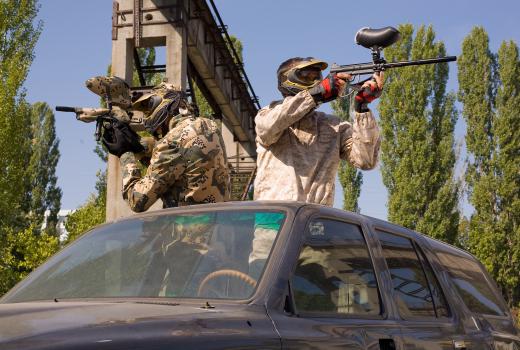At Sports&Hobbies, we're committed to delivering accurate, trustworthy information. Our expert-authored content is rigorously fact-checked and sourced from credible authorities. Discover how we uphold the highest standards in providing you with reliable knowledge.
What are the Different Types of Paintball Gear?
Paintball is an intense sport that can be played as either an individual activity or as a team. However, like most sports, paintball requires special equipment to play. Paintball gear can be divided into three basic categories: offensive equipment, worn equipment, and field equipment. Each of these categories and their contents will be explained in more detail below.
Offensive equipment is the category of paintball gear that players will usually spend the most money on. This category includes paintball guns, paintballs, air tanks, and gun accessories. A few of these in more detail include:

Paintball Gun: The most important piece of offensive equipment. There are many different types of paintball guns to choose from. Some models can be highly modified with accessories, while others can not. Paintball guns can be rented at most paintball facilities and paintball specialty shops.
Paintballs: The heart of the game. Paintballs come in different sizes and colors, and may have different shell thicknesses depending on the style and manufacturer. Veteran paintball players usually match the size their paintballs with the diameter of their barrel. Most general paintballs, however, can be used in standard guns.

Barrel Blocking Device (BBD): Safety is extremely important when playing paintball. When a paintball gun is not actively being used in a game, a BBD should be placed on it. BBDs prevent paintballs from accidentally being shot and injuring an unprotected person. They include barrel covers, barrel plugs, and barrel socks.
Barrel: Barrels of different lengths and diameters can be affixed to some paintball guns in order to improve accuracy.
Hopper: Paintballs that are fired from a paintball gun are usually stored in a curved container attached to the gun. This container is called the hopper. Hoppers come in different sizes and can accept accessories.
Loader: Loaders are hoppers that have been modified to more efficiently feed paintballs into the firing chamber of the gun. Most loaders use batteries. Loaders are often necessary to take advantage of improved triggers.
Trigger: Paintball guns can have improved triggers put on them in order to increase performance. Trigger types include automatic triggers, cranks, double triggers, electronic triggers, and rocking triggers.
Scope or Sight: Scopes and sights can be added to paintball guns in order to improve accuracy. Scopes magnify a specific area while sights attempt to pinpoint where the paintball will go.

Air Tank: Most paintballs are fired using air to propel them. The air is usually stored in tanks either fastened directly to the gun or worn on a player and connected to the gun by a hose. Guns must be set up to take either compressed air or carbon dioxide (CO2). Not all guns can take either gas.
Grenade: Paint grenades expose a large radius to paint shortly after the pin is pulled and the grenade is (hopefully) thrown. Paint grenades are expensive, and may be illegal on some paintball courses.
Worn equipment is paintball gear that the player wears. For almost everyone, this will include the protective face mask; veteran players, however, often wear additional items to improve their chances of winning. Worn equipment includes:
Full Mask: A full mask refers to three pieces of equipment worn as one: the hard mask that protects the face, mouth, and cheeks; the goggles that protect the eyes; and the visor that both protects and keeps glare from the eyes. Full masks are required at almost every paintball facility when playing.
Chest Protector: Paintballs can hurt when they hit. A chest protector provides either plates or padding that cushions and distributes the force of a paintball impact. Chest protectors are not required, but are recommended for players that get close to their opponents.
Neck Protector: A paintball to the throat is extremely rare, but can cause serious injury. Neck protectors can be worn to decrease the danger.
Pads: Elbow, groin (cup), and knee pads can be worn to protect joints and sensitive areas from damage.
Gloves: Fingers can be rubbed raw from pulling a trigger; paintballs can get under fingernails and cause a lot of discomfort. Gloves are highly recommended.
Tubes: Tubes are simple containers that hold extra paintballs. They are designed to easily fill paintball hoppers in the field. Most veteran paintball players carry tubes on them.
Harness: Harnesses strap on to players and hold extra tubes.
Tactical Vest: Contains pockets and tube holders.
Field equipment is paintball gear that can be used by anyone playing. It is usually provided by the paintball facility, and can include the following:
Flag: A colored piece of cloth that can be attached to a pole. Flags are often used for games such as capture the flag, base commander, and kill the runner.
Inflatables: These include inflatable boxes, bunkers, and cannons. They are usually found on indoor paintball fields, and are sometimes generically called bunkers.
AS FEATURED ON:
AS FEATURED ON:













Discuss this Article
Post your comments